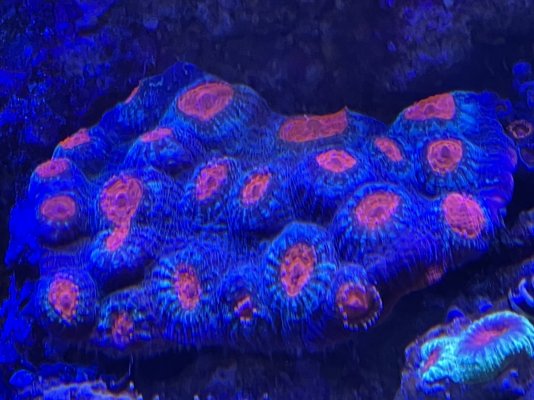Navigation
Install the app
How to install the app on iOS
Follow along with the video below to see how to install our site as a web app on your home screen.
Note: This feature may not be available in some browsers.
More options
You are using an out of date browser. It may not display this or other websites correctly.
You should upgrade or use an alternative browser.
You should upgrade or use an alternative browser.
Favia ID help
- Thread starter Rwade
- Start date
- Tagged users None
Any name is just a marketing strategy and is ultimately meaningless. Also, 95% sure that is a goniastrea.
So is the difference that the walls don’t touch? I have figured out diffences between Favia and Favites, but now you’ve thrown another player at me.Any name is just a marketing strategy and is ultimately meaningless. Also, 95% sure that is a goniastrea.
Some Goniastreas resemble Favias where the corallites don’t share a wall like Favites, and some look a lot like platygyra. They can be difficult to tell apart (goniastrea and favia). Goniastreas have somewhat more pronounced polyps and more prominent septal lobes (the sort of ridges around the mouth not the outer wall). Also, the color is unusual for a Favia. The thing is though, there are like 7-8 genera in the Faviidae/Mussidae families that are very similar (there are tens if not hundreds of species), and there have been a lot of reclassifications over the last decade. It can be nearly impossible to definitively ID corals like this without a detailed examination of the skeleton/corallite, and even then you may need DNA testing for some species. But, just based on the structure of both the polyp and the colony, and the color, I’m pretty sure it’s goniastrea (I’m guessing G. deformis).So is the difference that the walls don’t touch? I have figured out diffences between Favia and Favites, but now you’ve thrown another player at me.
Thanks so much for the details, I looked them up last night but couldn’t find anything that helped explain the differences.Some Goniastreas resemble Favias where the corallites don’t share a wall like Favites, and some look a lot like platygyra. They can be difficult to tell apart (goniastrea and favia). Goniastreas have somewhat more pronounced polyps and more prominent septal lobes (the sort of ridges around the mouth not the outer wall). Also, the color is unusual for a Favia. The thing is though, there are like 7-8 genera in the Faviidae/Mussidae families that are very similar (there are tens if not hundreds of species), and there have been a lot of reclassifications over the last decade. It can be nearly impossible to definitively ID corals like this without a detailed examination of the skeleton/corallite, and even then you may need DNA testing for some species. But, just based on the structure of both the polyp and the colony, and the color, I’m pretty sure it’s goniastrea (I’m guessing G. deformis).
The growth pattern does look a lot like this, more so than any of the others I’ve seen.Looks like a red eyed purple chalice coral or color variant . Looking more at the growth pattern of the coral.

Is yours fleshy with polyps that inflate or is more of encrusting and sort of stony.The growth pattern does look a lot like this, more so than any of the others I’ve seen.
It’s stony and more encrusting, it has pinkish orange coloring around the edges.Is yours fleshy with polyps that inflate or is more of encrusting and sort of stony.
Could be a chalice then (which is a vague category and could be several different genera/species). The photo looked more fleshy to me, but it can be hard to tell from a photo. Do you have a picture under white light?It’s stony and more encrusting, it has pinkish orange coloring around the edges.
I’ll try to get one tomorrow, lights are off for the night and fishies are asleep.Could be a chalice then (which is a vague category and could be several different genera/species). The photo looked more fleshy to me, but it can be hard to tell from a photo. Do you have a picture under white light?
It's probably a chalice, since after a reclassification, all favias are in the atlantic
In terms of the hobby, most people still use the name ‘Favia’ (similar to how people still call Micromussa lordhowensis ‘Acan lords’). Of the 91 species that were at some point considered ‘Favias’, 81 have been reclassified, 2 have been confirmed to be Favias, and 9 are sort of in limbo until more research can be done. The 2 Atlantic Favias are not in the hobby. The vast majority of the ‘Favias’ in the hobby are now Dipsastraea and Goniastrea (and a few Coleastrea and Favites). Within the hobby and coral retailers, there has started to be a distinction between Goniastrea and ‘Favia’ (Dipsastraea), but for whatever reason Dipsastraea, while technically correct, hasn’t really caught on amongst hobbyists and retailers.It's probably a chalice, since after a reclassification, all favias are in the atlantic
Could be a chalice then (which is a vague category and could be several different genera/species). The photo looked more fleshy to me, but it can be hard to tell from a photo. Do you have a picture under white light?
This is under white light. One other thing of note, it can eat a pretty big piece of food. I feed LRS and squirt some over this coral, each mouth will suck down whatever lands on it pretty quickly unless two mouths are playing tug of war.
I suppose it could be possible, none of my 3 Echinatas look the same. This one does have small 1/4” tentacles that extend from the polyps at times, my Echinatas do not have that.echinata perhaps?
Similar threads
- Replies
- 2
- Views
- 143
- Replies
- 3
- Views
- 120



















